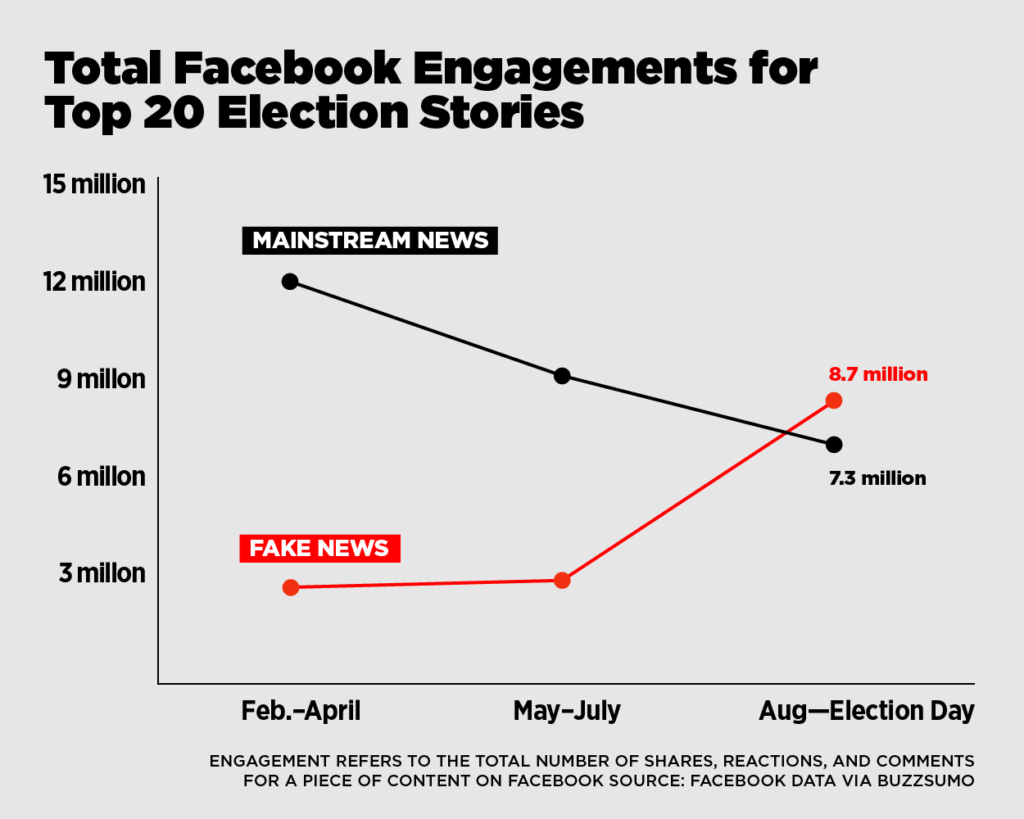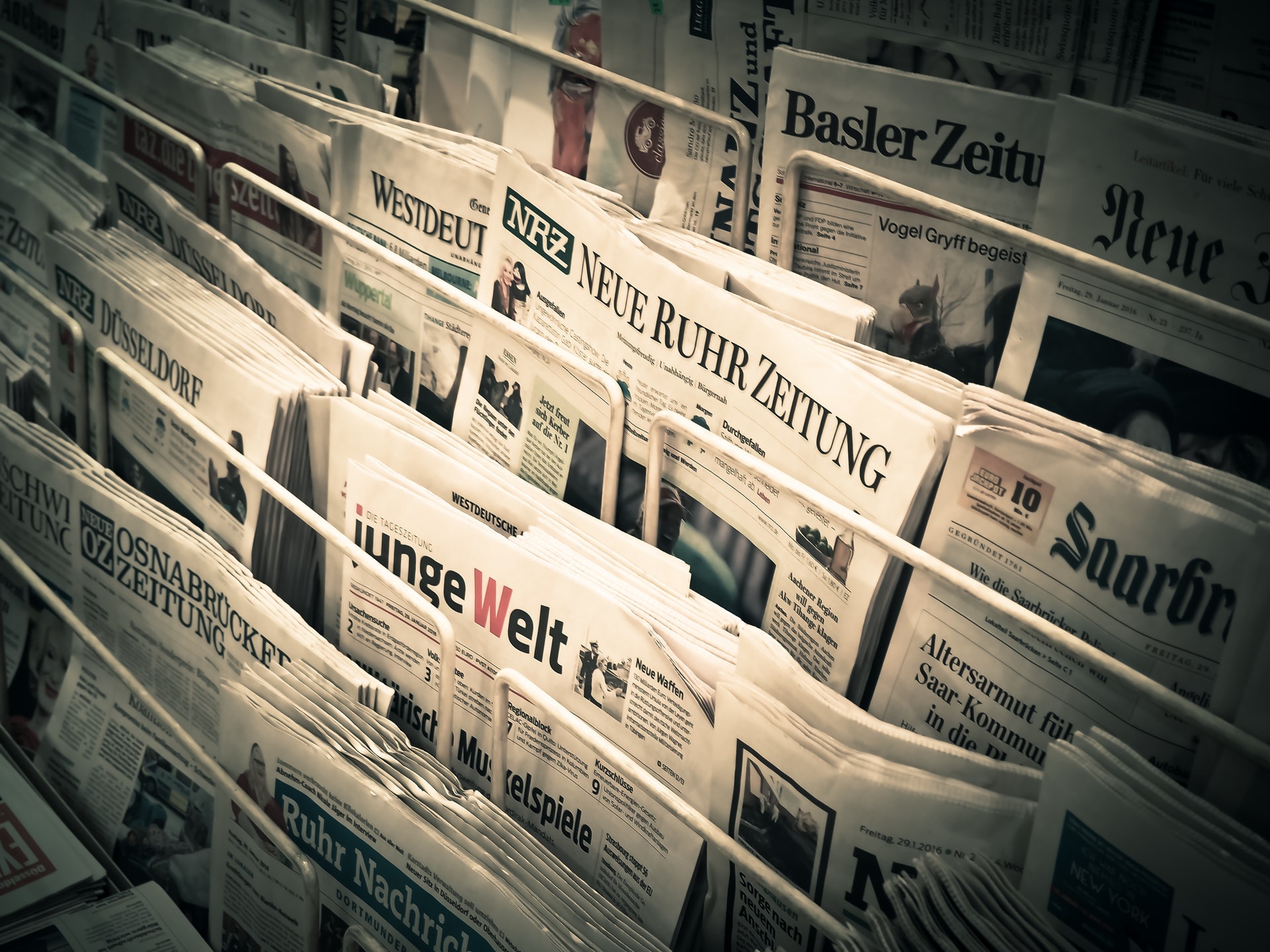After dozens of interviews with Press leaders, and 50+ years of combined technical experience as entrepreneurs, the Z Digital Agency Team came up with some massive trends shaping the future of the press, as well as a series of potential solutions for Media groups.
Thanks to its “Fake News” Twitter guerilla, the Drumpf administration re-launched some newspaper subscriptions like the New York Times. But one graph could summarize the entire crisis of 2016:

Yes, during the last part of the 2016 US election, the Facebook engagement for Fake News took over the engagement for the top 20 stories from traditional media covering this event.
According to a recent study from Forrester, people trust search engines more than traditional media as information sources.
“A recent survey showed that users spent on average 50 minutes per day for scrolling on Facebook’s platforms in comparison to 5 minutes they spent for reading the newspaper,” Juliane Leopold
We have seen two main trends over the past decade:
- The GAFA are controlling more and more traffic to Press websites (>50% since 2014)
- The classic revenue streams for Press have been drained: classifieds (moved to specialized websites) and advertising (gone to cheaper and more traceable traffic sources, mainly controlled by the GAFA)
What new value added for the press?
- Fact-checking: “If information is not reliable and verifiable, it is at best useless and at worst dangerous,” newspaper publisher Ken Waddell
- Investigative journalism: how to bring value in a world of automation with AI and digital archives?
- Building authority against the tyranny of social media engagement: the need for new brand metrics
- Building an ecosystem with multiple points of view: thanks to technology and user interface (more below)
- Counterpower: no comment.
Journalists are not vouching for the truth
Artificial Intelligence will help bringing the cultural cognition analysis to an industrial scale for press groups, while the social media giants will provide a bigger and bigger bubble effect to their users. This may be the long-term advantage of press groups over the Silicon Valley giants.
The press reaction to silicon valley giants
- accept that they are in the advertising business but the point of control has shifted to platforms and thus the point where margins accrue has also shifted. In that case, publishers need to jettison as many of their costs as possible and assume the mentality and framework of a low-cost/low-margin scale provider.
- if they decide they want margin more than scale, they need to plan for a non-advertising future with multiple revenue streams, not just the access model. The total revenue might be smaller but the margin larger.
The challenge for the publishers is, in general, an unwillingness to make a hard decision. They end up sitting in the middle trying to optimize for both, which means optimizing for neither.”
Answer #1: Build a common advertising platform for a consortium of Press groups
- Offer global tracking to advertisers, across several platforms
- Offer tailored services depending on advertisers’ product positioning
- Offer full advertising solutions for advertisers’ campaign, as an alternative to the GAFA
This move was necessary, but not sufficient.
The technology should be at the center of their strategy, to really compete with the GAFA. Indeed Media groups advantage lies in their ability to focus on specific needs, not the entire advertising industry. We will detail some technological moves further below.
Answer #2: Go local
Local Newspapers have been very resilient to the Media crisis. History already taught us a lesson with the story of the Tenby Observer in 1978.
According to a 2016 study from the Advertising Association, digital ad spend in local media is forecast to grow faster than any other media, except video (another interesting move of vertical integration to be detailed further below).
Local newspapers have a responsibility: give local communities a voice and representation.
More than 60% of a household budget is still spent in an area less than 20 km far from home. Local classifieds and local advertising solutions are still to grow. Google Local Business solutions are not currently replacing other advertising solutions. Additionally, the ever-increasing cost per click of Adwords campaigns (due to growing competition, but also due to most Adwords budgets being spent on broad keywords) is a good reason for advertisers to prefer local media solutions, both for branding and traffic goals.
To put it in a nutshell, media groups have started taking some risks. As Will Lewis, chief executive of Dow Jones recommended: “invest in innovation, harness technology rather than be led by it, get ever closer to customers, diversify revenue streams, attract the best talent you can and – crucially – reinforce journalism’s civic role: holding the powerful to account through the power of great storytelling.”
New monetization solutions for the Press
Like Wikipedia, several Newspapers have tapped into their audience to fill empty pockets, and face their overheads. It is actually a great way to measure their impact and fund the launch of new strategies. However, it is not a sustainable stream of revenues. Some niche newspaper were even created thanks to crowdfunding campaigns, exactly like for startups, aiming at a specific need and audience.
This model requires a very light and flexible team, to keep the cost at their minimum, but also a niche and need-based model.
- Like e-book websites, some media websites offer a teaser of the key learnings in this article
- Some websites are currently offering two micro-payments choices: monetary or watch a 15 seconds advert. An interesting model to really target the right audience for advertisers (depending on the article topic) and guarantee a meaningful experience for the reader, making the advert more impactful.
“Nobody hates ads, but everybody hates irrelevance.”
- Create a Single Sign On (SSO) across platforms, within one or several media groups, to better track users
- Use Artificial Intelligence to better map the user profiles and interests, by filling the holes in current data sets with algorithmic predictions.
- Create multiple buyer personas by entering the e-commerce market, as affiliates or as deals providers (classic), but also as real e-commerce for digital contents (books, courses, etc…). Whether these e-commerce are successful or not, they will allow media groups to gather larger data sets and create qualified client persona for their advertisers.
Who is better at telling daily stories than journalists? Today’s brand management is all about storytelling across multiple touch-points. Some media groups started offering tailored storytelling and series of multi-angles promotions. Several formats and platforms are therefore required to operate such campaigns for luxury brands, product launches, etc.
On the format first. Audio, video, interviews, redacted contents and photography based storytelling are the minimum requirements for a press group to perform at those Haute-Couture capsules. Remote workers, freelancers or partner agencies are key to succeeding at creating the ecosystem, while maintaining low overheads.
On the platforms now. When launching an advertising campaign, premium brands require multiple touch points, all highly segmented. It requires high-quality data set (see it as a personal invitation to a haute-couture catwalk event for instance). It also requires several platforms, from buzz to very niche audiences.
Some media groups like Axel Springer, for instance, got it right by purchasing very specific audiences, to answer its advertisers target groups. Last but not least it requires a succession of touch points. Press groups will have to map their customers’ journey across platforms (press websites and even printed newspapers) to allow better retargeting. On average a client purchases after 6 interactions with the ads.
It also goes without saying that Media groups should vertically integrate more of the value chain, from ideation, story-boarding to edition, publishing and revenue management.
A good example is Canal +, the french private TV channel, which purchased Studio Bagel, a creative agency for short stories formats that was initially broadcasting on its own web channels.
Actionable advertising inside contents and videos
As printed press went digital, text is being replaced by video (and faster than we think). Engagement rates for videos are through the roof, and production rates have dramatically decreased.
The GAFA are investing heavily in video advertising, but they are building automated systems, a one size fits all solution. On the other hand press groups (still) have editing capabilities. Human understanding of context is still far beyond current commercial AI applications. Therefore media groups have the ability:
- To insert advertising at the right place and the right moment. It requires some investment in journalists and editors training.
- To design and capture more videos, while offering innovative and tailored ad placements to their advertisers, with the very same tracking capabilities as the GAFA. Some startups like Adways, for instance, created very powerful editing tools to bring advertising interactivity to videos, natively.
- To invest in programmatic technologies that can “augment” its unique human resources capabilities (for journalists and editors to bring tailored services at an industrial scale).
The future of Media
Press as an experience
Local Vs International
Data privacy: the sword of the press
Data standards
Less is more: Press groups as a quality stamped filtering system
Media groups as learning centers
Leveraging technology to be at the center of the learning economy
Leveraging technology to build a new objectivity
Being a journalist in the 21st century
- writing 10x better content than the average (a famous rule for online conent marketers)
- providing value (like the Washington Post on Reddit, with its non promotional ultra helpful presence)
- bringing back trust and multi-angle points of view at a larger scale
- innovating for their advertising clients
